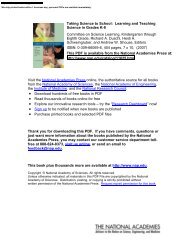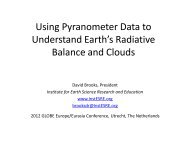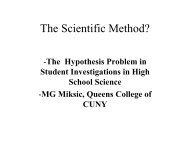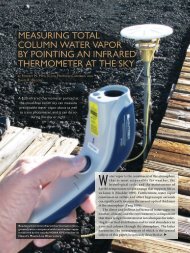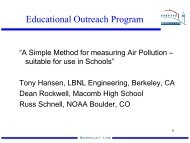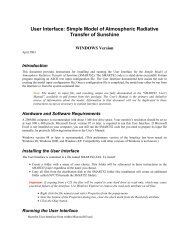Estimating Cloud Type from Pyranometer Observations - American ...
Estimating Cloud Type from Pyranometer Observations - American ...
Estimating Cloud Type from Pyranometer Observations - American ...
You also want an ePaper? Increase the reach of your titles
YUMPU automatically turns print PDFs into web optimized ePapers that Google loves.
JANUARY 1999 DUCHON AND O’MALLEY<br />
133<br />
FIG. 1. The basis for using a pyranometer to estimate cloud type<br />
is that the clouds cross the solar beam impinging on the sensor, thus<br />
providing a time series of global irradiance fluctuations due to clouds.<br />
the average irradiance of surrounding stations is about<br />
0.9 (80% variance in common) for an area within a 30-<br />
km radius and decreases rapidly as the radius increases.<br />
The average station spacing in the Oklahoma Mesonet<br />
(Brock et al. 1995) is between 30 and 35 km (the data<br />
source <strong>from</strong> which Barnett et al. 1998 performed their<br />
analysis) so that an interesting study comparing ISCCP<br />
and pyranometer cloud-type estimates might be performed.<br />
It seems obvious at the outset that the inclusion of<br />
other atmospheric radiation measurements such as diffuse,<br />
direct, and atmospheric soundings can only improve<br />
the estimation of cloud type derived <strong>from</strong> a single<br />
instrument. However, the additional instrumentation is<br />
available only at a few locations, for example, the Department<br />
of Energy Atmospheric Radiation Measurement<br />
(ARM) sites in Oklahoma, Alaska, and the southwest<br />
Pacific. Our interest here is predicated on taking<br />
advantage of the good accuracy, simplicity, low cost,<br />
robustness, and minimum maintenance associated with<br />
state-of-the-art pyranometers.<br />
The outline of the remainder of the paper is as follows:<br />
section 2 provides the basis for using a pyranometer<br />
to estimate cloud type, section 3 discusses the irradiance-based<br />
classification method, section 4 describes<br />
the clear-sky irradiance model for standardizing<br />
irradiance measurements, and sections 5 and 6 compare<br />
irradiance-based cloud-type estimates with human observations<br />
of cloud type. A summary and conclusions<br />
are given in section 7.<br />
2. <strong>Pyranometer</strong> response to clouds<br />
A pyranometer measures the hemispheric broadband<br />
solar radiation available to drive the daytime surface<br />
energy budget. These measurements naturally integrate<br />
the effects of clouds. The concept of using a pyranometer<br />
to estimate cloud type is illustrated in Fig. 1 in<br />
which comparatively fast-moving clouds cross the slowmoving<br />
path of the solar beam. For cloud bases at 1 km<br />
the speed of the solar beam varies <strong>from</strong> 0.07 overhead<br />
FIG. 2. Comparison of diffuse and global irradiance for (a) a clear<br />
day, (b) a partly cloudy day, and (c) a mostly cloudy day at Norman,<br />
OK, for 12 July, 5 August, and 11 September 1995, respectively.<br />
to 2.4 m s 1 at a zenith angle of 80, while at a cloud<br />
base of 10 km, the comparable speeds are 0.7 and 24.1<br />
ms 1 . Because of the secant squared dependence on<br />
zenith angle, at very high cloud bases and large zenith<br />
there will be times when the cloud speed is similar to<br />
the speed of the solar beam.<br />
With clear skies the irradiance signal is dominated by<br />
the solar beam. Diffuse irradiance is around 15% of the<br />
total irradiance (at least in the southern plains). With<br />
variable cloudiness, the signal fluctuates principally in<br />
response to the occurrence or nonoccurrence of clouds<br />
intersecting the path between the sun and the pyranometer.<br />
When clouds are present along the beam path, the<br />
diffuse radiation as a fraction of the signal increases and<br />
becomes nearly indistinguishable <strong>from</strong> the total irradiance<br />
in overcast skies. That is, as the irradiance signal<br />
decreases due to increasing cloud thickness in the beam<br />
path, a correspondingly larger fraction of the sky surrounding<br />
the beam path contributes to the irradiance<br />
signal. This is shown in Fig. 2 for a clear day, in which<br />
the diffuse irradiance is about 15% of the global irradiance;<br />
a partly cloudy day, where the diffuse to global<br />
ratio is variable but greater than 15%; and a mostly<br />
overcast day, where the global and diffuse irradiances<br />
are essentially equivalent. Note in Fig. 2 that frequent<br />
sampling is necessary to capture the rapid variations in<br />
irradiance. In our case, the instantaneous sampling rate<br />
is once per second; the samples are then averaged over<br />
1-min intervals to yield the data used in this study.<br />
In summary, the time series of irradiance captures the<br />
character of the cloudiness weighted toward the portion<br />
of the sky where the sun is located and provides the<br />
basis for estimating cloud type. Because the fluctuations<br />
due to clouds are in proportion to the clear-sky solar<br />
irradiance, which varies systematically during the<br />
course of a day, the resulting time series of irradiance




